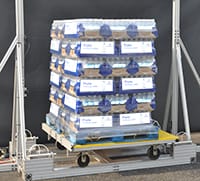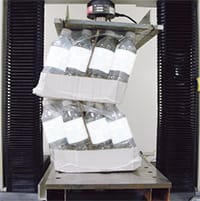Transportation Packaging & Unitized Loads


Package designers and engineers are accustomed to dealing with hazards that can damage their packages such as top load stacking forces and more dynamic handling and transportation events like drop impact and vibration. New challenges are being added to this list as the use of shrink-wrapped caseless secondary packaging, primary package light weighting, and other packaging material reduction and substitution activities continue to accelerate.
Many of the traditional package design and test methods were developed in a time when primary packages could be more robust and almost everything was shipped in a corrugated box. As the packaging industry becomes ever more innovative and cost sensitive, package designers and brand owners need to have confidence in the performance of their creative new packages without always having clear guidance about how to design or test them.
Stress Engineering Services has developed a number of physics-based, nonlinear modeling, simulation and test methods to predict the response of packages to a variety of primary and secondary loads. This approach eliminates much of the traditional trial and error development by providing information about the performance of packaging systems earlier in the design process, often before physical samples are available. The reductions in risk, cost, and speed to market that result can be significant.
Physics-Based Approach
We recognized a long time ago that there is a lot of value in approaching packaging performance with a strong grounding in the underlying physics. The methods that have evolved utilize a combination of our extensive analytical expertise, classical mechanics computations, and advanced computer-based simulation techniques. By applying this approach, our engineers are able to systematically examine the behavior of packaging systems.
Testing Methods
We are continually developing new test and simulation methods in support of unit load performance analysis. In the field or in the lab, our engineers and technicians have conducted a wide variety of test procedures on primary and secondary packaging for evaluating structural response under various manufacturing line, shipping, distribution, storage and handling loads. Our experience in packaging design and analysis, coupled with our extensive data acquisition skills and advanced instrumentation capabilities allows us to provide the most reliable solutions.
Additional Information:
Our Capabilities
At Stress Engineering Services, we offer the following capabilities:



